Welcome to our guide on how to install a linear piston air pump in a fish room. If you love keeping a lively aquatic world, knowing about a good air pump is key. A linear piston pump for aquarium helps keep your fish healthy and active. This guide will help you from start to finish, making sure you pick the best air pump for fish rooms.
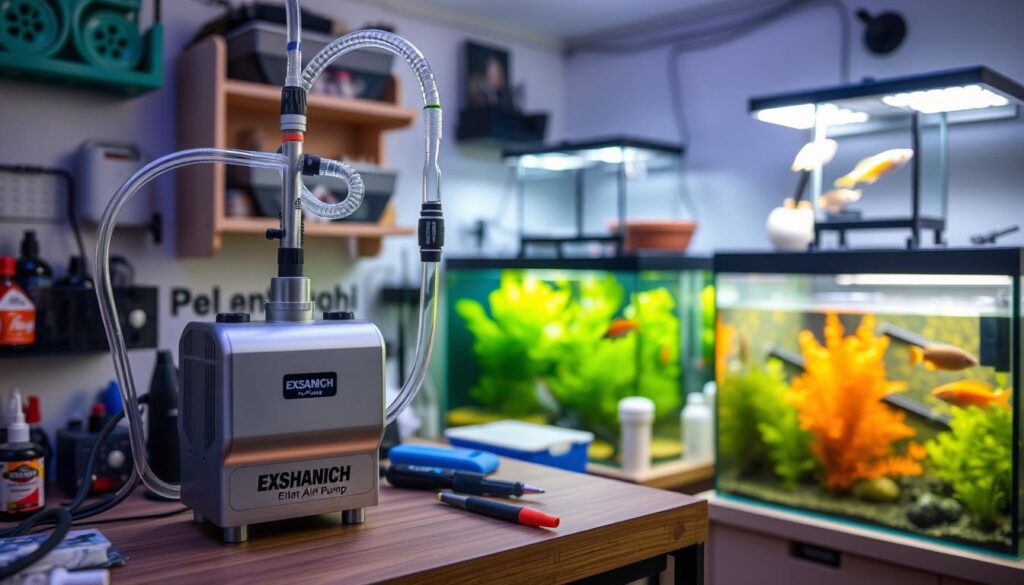
Let’s dive into the important steps and tips for a great home for your fish.
Understanding Linear Piston Air Pumps
Linear piston air pumps work by moving back and forth to create airflow. This makes them different from other pumps, like diaphragm pumps. They are known for being efficient and quiet, making them durable for fish tank aeration systems.
These pumps are great for big tanks or setups with many tanks. Knowing the aquarium air pump features of linear piston air pumps helps you pick the best equipment for your needs.
- High efficiency in delivering airflow
- Quiet operation compared to alternative options
- Durability with a long lifespan
- Ability to service larger aquariums
Looking into these features shows how choosing a linear piston pump can meet your fish room’s aeration needs.
| Feature | Linear Piston Air Pumps | Diaphragm Pumps |
|---|---|---|
| Airflow Consistency | High | Moderate |
| Noise Level | Low | Higher |
| Durability | Longer Lifespan | Shorter Lifespan |
| Best Use | Large Tanks/Multiple Tanks | Small Tanks |
Benefits of Using a Linear Piston Air Pump
Using a linear piston air pump in your fish room has many benefits. One key advantage is its low energy use. This makes it efficient for keeping your aquarium well-aerated. It also means you’ll save on electricity and your equipment will last longer.
These pumps are great at providing a steady flow of air. This is important for keeping your fish healthy. They can handle more air than old-style pumps, which is good for big tanks or setups with many tanks.
Another benefit is how quiet these pumps are. They make less noise, which helps keep your fish room peaceful. This is good for both your fish and for you, as you can enjoy your setup without noise.
Linear piston pumps are also very reliable. They have fewer parts, so they’re less likely to break down. This means your air supply will keep working without interruption. If you want the best for your fish, knowing about these pumps is key.
| Feature | Linear Piston Air Pump | Traditional Air Pump |
|---|---|---|
| Energy Efficiency | Low consumption, cost-effective | Higher consumption, less efficient |
| Air Volume Handling | High volume for large tanks | Limited volume capacity |
| Noise Levels | Quiet operation | Typically noisy |
| Durability | Long-lasting, reliable | More prone to mechanical issues |
These points show why many aquarists choose linear piston air pumps. They help keep their fish healthy and thriving.
Choosing the Right Air Pump for Your Fish Room
Choosing the right air pump is crucial for a healthy fish room. Think about your aquarium’s size, the fish types, and the water volume. It’s important to match the pump’s specs to your aquarium’s needs.
Best linear piston air pumps offer steady airflow and are quiet. They’re perfect for indoor fish rooms. There are many models available, each with different air outputs and specs. Here’s a look at some popular ones.
| Brand | Model | Air Output (L/min) | Noise Level (dB) | Price (INR) |
|---|---|---|---|---|
| AquaAir | Model A | 40 | 20 | 5000 |
| ACO | Model B | 50 | 25 | 6000 |
| AquaAir | Model C | 60 | 22 | 7000 |
Reading reviews can help you understand how different models perform. Look at the air pump specs for aquariums. They affect your fish’s health and your room’s atmosphere. Getting advice from trusted sources is key. With the right air pump, your fish room will flourish.
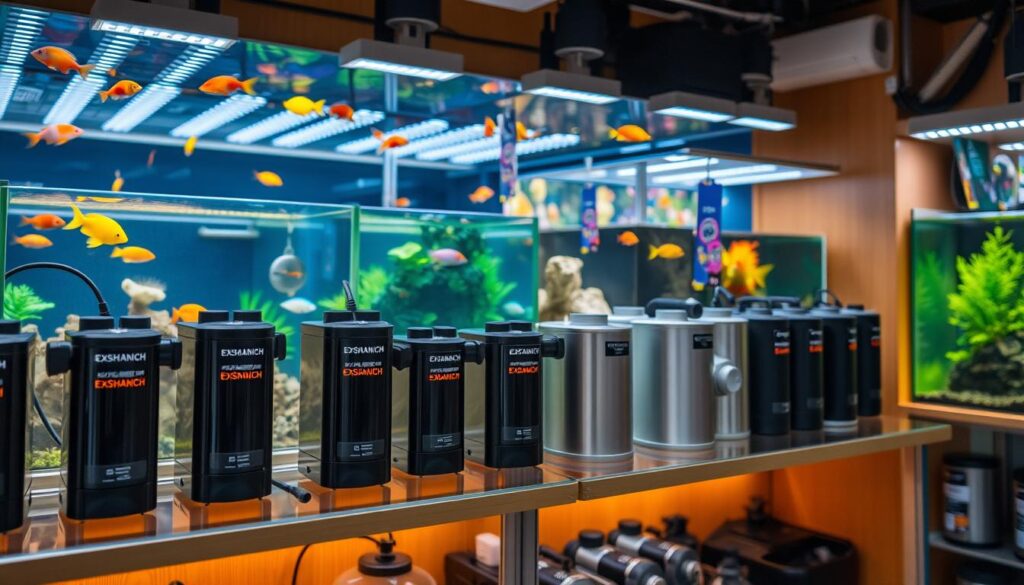
How to Install a Linear Piston Air Pump in a Fish Room
Adding a linear piston air pump to your fish room boosts the aeration system. It’s simpler with a clear guide. Here’s what you need for a successful setup.
Gather Necessary Tools and Materials
Before starting the linear piston air pump installation, make sure you have the right tools and materials. You’ll need:
- Screwdrivers
- Wrenches
- Hose connectors
- Hose clamps
- Mounting brackets
Prepare Your Fish Room for Installation
Getting ready is crucial for a smooth DIY fish room air pump installation. Choose a spot for your pump that’s not too wet or drafty. An organized area makes the installation easier.
Step-by-Step Instructions for Installation
Follow this step-by-step air pump installation guide as you go:
- Mount the pump on the wall or surface securely.
- Use hose clamps on the air tubing for a tight fit.
- Connect the air tubing to the pump’s output.
- Run the tubing to each tank, cutting it to size as needed.
- Check all connections for leaks and tighten if needed.
- Plug in the pump and test it to make sure it works right.
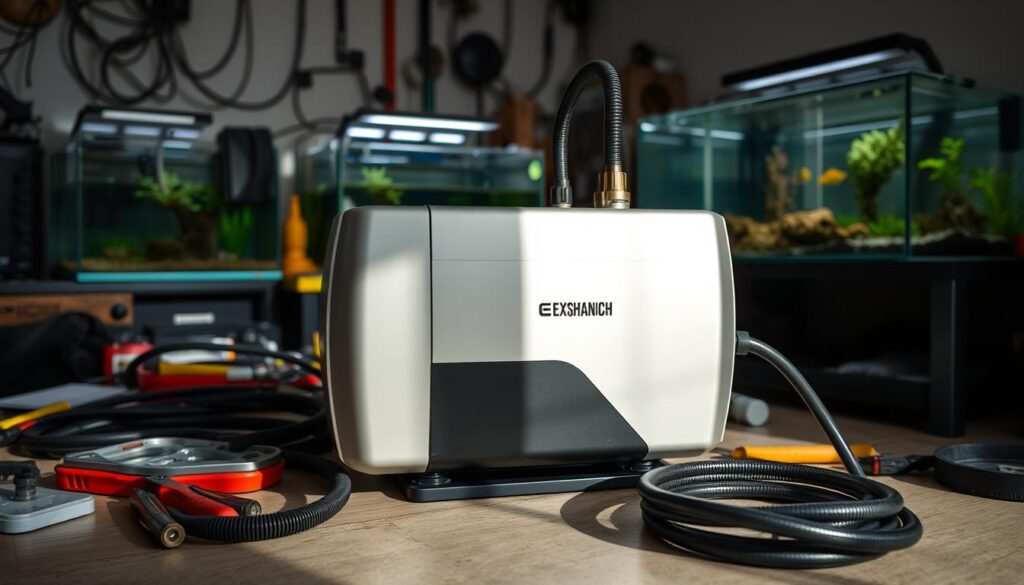
Linear Piston Air Pump Placement Tips
Placing your linear piston air pump right can boost its performance and keep your fish room calm. Finding the perfect spot for your air pump helps it work well. It also keeps your fish room peaceful.
Ideal Locations for Pump Installation
Here are some tips for placing your air pump:
- Put the pump near a power outlet to avoid long cords.
- Place it in a spot with good airflow.
- Keep it away from water to prevent damage.
- Make it easy to reach for upkeep but not in busy areas.
Preventing Excess Noise and Vibration
It’s important to keep your fish room quiet. Here’s how to reduce noise:
- Mount the pump on a rubber mat or pad to dampen vibrations.
- Make sure the area under the pump is even and stable to avoid rattling.
- Check for loose parts that might make noise.
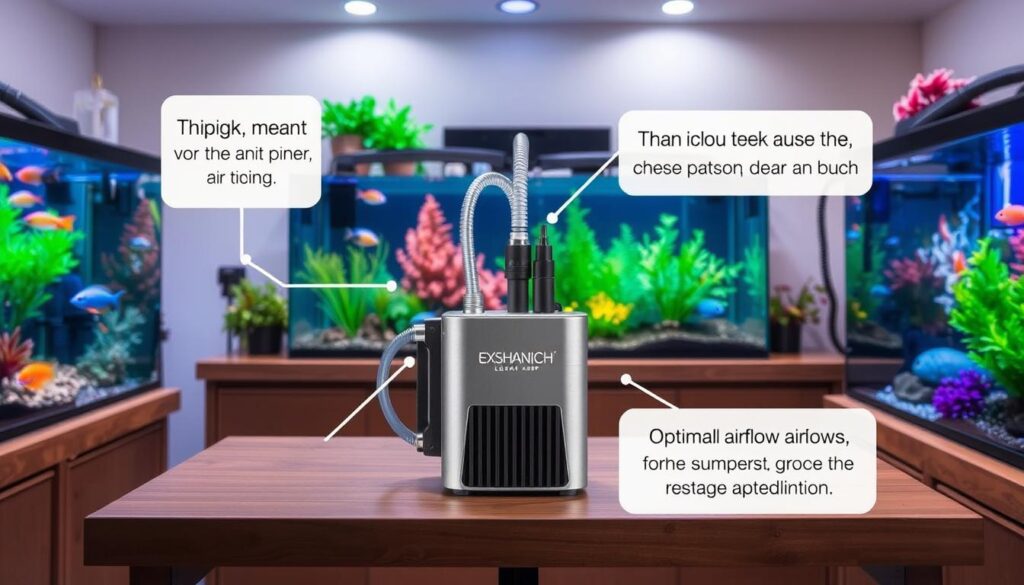
Setting Up Air Tubing and Connectors
Setting up air tubing for fish tanks is key to keeping them healthy. The right tubing material, like silicone or PVC, boosts system performance. Think about the tubing length you need, which depends on your tank’s size and layout.
Using strong air tubing connectors is crucial to avoid leaks. Good connections ensure air flows well, which is vital for your fish room aeration setup. Always check these connections to keep your system running smoothly.
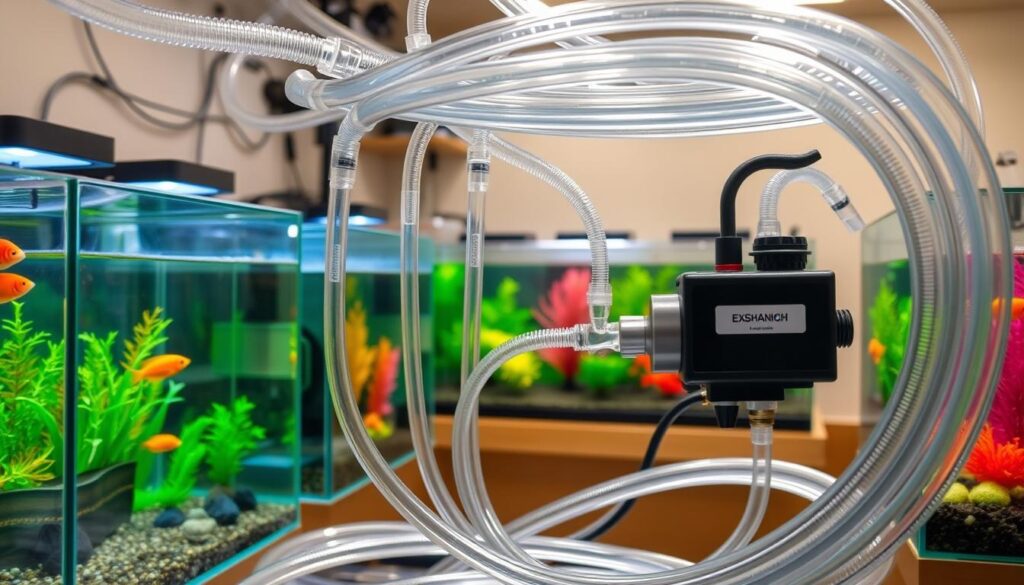
Keeping your fish room neat makes it more attractive. Here are some tips for managing your air tubing:
- Run tubing along edges and corners to hide it.
- Use cable ties or clips to keep tubing organized and untangled.
- Label your tubing if you have multiple tanks to connect, to avoid confusion.
| Tubing Material | Flexibility | Durability | Recommended Use |
|---|---|---|---|
| Silicone | High | Good | General use, tight bends |
| PVC | Medium | Excellent | Long runs, less flexibility needed |
| Rubber | High | Moderate | High-pressure systems |
By following these tips, you’ll have a neat and efficient fish room aeration setup. This setup will help keep your aquatic pets healthy.
Optimal Air Pump Configuration for Fish Tanks
Setting up your air pump right is key to a healthy home for your fish. The right setup makes sure each tank gets enough air without wasting energy. By smartly connecting and distributing air, you can manage many tanks with just one pump.
Connecting Multiple Tanks to One Pump
Linking many tanks to one air pump saves money and space. Use a manifold or tubing to spread air evenly. Here’s how to connect them well:
- Select the right size manifold: A good-sized manifold handles air for many tanks well.
- Use airflow control valves: These valves keep air flow right, so tanks don’t get too much or too little.
- Prioritize tank sizes: Put bigger tanks on the main line and smaller ones after to keep air pressure steady.
- Regularly assess airflow: Check air flow in each tank often to keep your setup working best.
Adjusting your setup is crucial to meet all your tanks’ needs. Knowing how to connect tanks well makes your air pump system more efficient and sustainable.
Best Practices for Maintaining Your Air Pump
Keeping your air pump in top shape requires a plan. Regular maintenance is key for both performance and longevity. A set schedule for upkeep helps prevent breakdowns and keeps your system running smoothly.
Regular Maintenance Schedule
For consistent performance, a regular maintenance routine is crucial. Important tasks include:
- Cleaning filters and check valves monthly to prevent clogging.
- Inspecting and replacing damaged tubing as needed.
- Checking the pump’s exterior for dust and debris regularly.
- Monitoring for unusual vibrations or noises, which could indicate issues.
Identifying Common Issues
Spotting common problems helps in keeping your pump in good condition. Look out for these signs:
- Decreased airflow, which may suggest blockages in the tubing.
- Increased noise levels, indicating potential mechanical problems.
- Overheating of the pump, potentially due to lack of maintenance.
DIY Fish Room Air Pump Installation Tips
Setting up a DIY fish room air pump is a rewarding task. It’s a great way to improve your space. Follow these easy tips to make the process smoother and more fun.
First, figure out what you need. The size of your tank and how many connections you need will determine your setup. Before you start, draw a plan of where everything will go. This helps avoid changes later on.
- Select quality materials: Use durable PVC pipes instead of regular tubing. They’re better for customizing and are more stable.
- Check power supply: Make sure the power source can handle your pump’s needs. A reliable power source helps avoid problems later.
- Minimize noise: Place the air pump on a soft surface or use vibration-damping pads. This reduces noise while it’s running.
Setting up an air pump system means connecting tubing to several tanks. A manifold helps distribute air evenly. Always check connections for leaks to keep efficiency high.
With these simple DIY tips, you can set up a great air pump system. Planning and using quality materials make the setup efficient and effective. Your fish room will flourish.
Enhancing Your Fish Room Aeration System
Improving your fish room’s health is key. Enhancing fish room aeration is crucial. It helps keep water quality high by exchanging gases for fish survival.
Look into air pump system upgrades to boost your setup. Air stones help spread oxygen evenly, avoiding stagnant spots. Oxygen diffusers also create fine bubbles for better gas exchange.
Using inline filters can improve water movement. They enhance filtration and aeration, keeping your fish healthy. Regularly check air quality to ensure your fish thrive in a balanced environment.
By investing in these upgrades, you can keep your fish room healthy. A well-aerated space supports fish health and boosts biological filtration. This makes your aquarium more lively.
Conclusion
Installing a linear piston air pump in your fish room is key for great fish room aeration. This guide has given you the tools to pick the best pump, install it right, and keep it running well. By doing this, you’ll create a healthy space for your fish to thrive.
Linear piston pumps are known for their efficiency and dependability. They provide steady airflow, which is good for your fish’s health and makes your aquarium look better. Learning how to take care of your pump will help your fish tank flourish.
Putting in the work to set up and care for your air pump will pay off. You’ll see better water quality and healthier fish. Follow these tips to make your fish-keeping journey more rewarding.
FAQ
How do I install a linear piston air pump in my fish room?
To install a linear piston air pump, you’ll need tools like screwdrivers and hose connectors. Choose a spot in your fish room that’s safe from water. Follow a guide to mount the pump and connect the air tubing to your tanks.
What are the benefits of using a linear piston air pump for my aquarium?
Linear piston air pumps use less energy and are reliable. They provide steady airflow, great for any size aquarium. Plus, they’re quiet, making your fish room peaceful for everyone.
What should I consider when choosing a linear piston air pump for my fish room?
Think about your tank size, the fish you have, and the water volume. Look at air output, noise levels, and what others say. This will help you pick the right pump for your needs.
How can I properly place my linear piston air pump in my fish room?
Put the pump near a power source and in a spot with good airflow. Use rubber mats or pads to cut down on noise and vibration. This makes your fish room better for everyone.
What are the best practices for maintaining my linear piston air pump?
Keep your pump in good shape with regular cleaning and checks. Make sure the tubing is clear and watch for any problems. This helps your pump last longer.
Can I set up multiple tanks using one linear piston air pump?
Yes, you can connect several tanks to one pump. Use manifold systems or tubing to spread the air evenly. This ensures each tank gets enough air without too much or too little.
What are some DIY tips for installing a linear piston air pump?
For a DIY install, think about using PVC pipes for custom setups. Plan your electrical setup carefully. Learn from others to make the process easier.
How can I enhance the aeration system in my fish room?
To improve aeration, add air stones, oxygen diffusers, and inline filters. Also, check the air quality often. This keeps your aquatic ecosystem healthy and thriving.

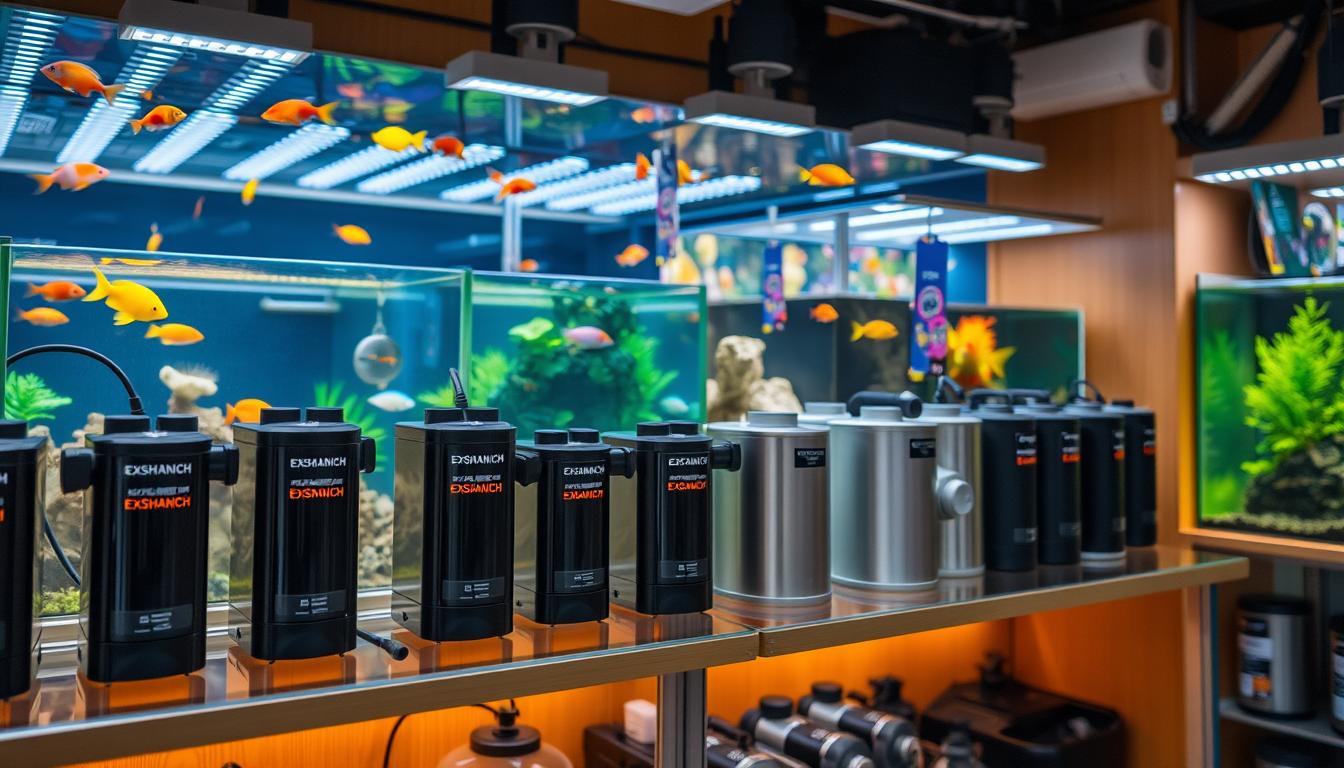


 No products in the cart.
No products in the cart.